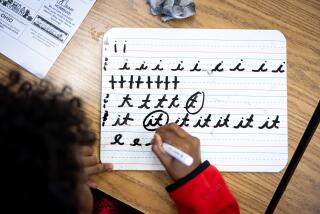Write Approach Might Prevent a Cursive Fate : Handwriting Analysis Is Growing as a Tool in Understanding--and Maybe Resolving--Personality Differences
- Share via
Jess E. Dines of Laguna Beach is 60, single and, when it comes to deciding whom to ask out, very selective.
Dines is interested only in women who’ve passed a test that he finds far more revealing than talk.
“I won’t date anybody until I look at her handwriting,” he says. “I can tell how honest, how sexual and how secure a woman is by the way she writes.”
Handwriting would be kept as private as lingerie if everyone could see the significance behind the way people cross their t’s and dot their i’s.
Not every woman is eager to submit a handwriting sample before the first date, but Dines has won enough cooperation to be able to say that his hobby has improved his love life.
An interest in exploring ways in which handwriting analysis can improve relationships is what brought Dines and about 30 others to the Adult Children Center in Orange recently for a seminar led by graphoanalyst Sister Mary Sevilla, a member of the order of Sister of St. Joseph of Carondelet.
For some couples, handwriting analysis can be disconcerting because it reveals--or confirms--basic personality differences that may make them wonder how they manage to stay together.
But you don’t need matching handwriting--or personalities--to make a relationship work; what’s important is understanding differences that might cause conflict, Sevilla says.
Her desire to help couples become more compatible is what led her to begin using handwriting analysis in her practice as a marriage, family and child counselor at the Adult Children Centers in Orange and Long Beach.
“I try to show people how to make their differences work for them as a couple rather than against them,” Sevilla explains. “They can complement each other beautifully or tear each other apart.”
Sevilla, 55, who has been certified by the International Graphoanalysis Society in Chicago, offered the participants at her recent seminar a crash course that had them carefully checking their own handwriting against the samples she analyzed. (There were a few skeptics in the audience--including a man who whispered to his wife, “This is just like palm reading.”)
Graphoanalysts draw conclusions about personality from the direction in which handwriting is slanted, the degree of pressure that is applied and the style of each stroke.
For example, Sevilla told her audience, people whose writing slants to the right tend to be warmhearted, affectionate and outgoing while those whose letters lean to the left are more likely to be self-centered and introverted.
(Sevilla noted that a dramatic change in handwriting slant--from right to left--sometimes results from trauma. “We pull all those emotions in and just check out because it’s too painful and we don’t want to feel,” she says, explaining that the victims’ handwriting gradually slants back to the right as they go through the healing process.)
Those with vertical handwriting tend to be ruled by their head rather than their heart.
“These people are objective, poised--some might even call them cold fish,” Sevilla says. “They are the ones who say, ‘Of course I love you--isn’t that enough?’ And that’s supposed to last 25 years.”
Some people write with a slant that veers from right to left and back, indicating a proclivity toward emotional ups and downs that even-tempered mates may have difficulty keeping up with.
People who write with a light touch usually have an upbeat personality, but Sevilla calls them “the butterflies of the world” because they also tend to flit from one emotion to another--and have short memories. They may regret something they said or did and apologize profusely, then quickly forget their mistake and repeat it.
Those whose writing is “heavy” usually have an “indelible emotional memory,” Sevilla says. This can be useful artistically--”these are the touchy, feely people; their senses are very alive”--but difficult in day-to-day life when they find themselves reliving negative feelings from long ago.
Handwriting size is also significant, Sevilla notes. Large letters are the mark of an extrovert with boundless enthusiasm “who processes information by talking out loud.”
Small letters, on the other hand, belong to introverts who weigh their thoughts before they speak. “These are people who have a natural ability to concentrate and to stick to something a long time. They see details,” Sevilla says.
Extroverts and introverts often complement each other at home and in the workplace, she notes. The extrovert usually takes charge and focuses on the big picture, while the introvert handles the details that might otherwise be overlooked.
The appearance of each letter also is illuminating to experts such as Sevilla, who has analyzed handwriting for nuns with whom she has lived in small religious communities and for corporations evaluating prospective employees.
The letter t --which tells her more about personality than any other because it is written in so many different ways--played a major role in her work with one couple who came to her for therapy, she says.
Bob was depressed because he had reached a dead end in his career and couldn’t figure out why. He also had been estranged from his son for three years and was constantly criticizing his wife, Jackie, who didn’t know how to fight back.
When couples in therapy seem unable to move forward, Sevilla often suggests handwriting analysis to help them step back and look at themselves and each other in a new way. It worked for Bob and Jackie.
Sevilla could see by the way they crossed their t’s--with the bar low on the stem--that both suffered from low self-esteem. Bob’s handwriting also showed a tendency toward sarcasm that was hurting his relationships at work as well as at home.
Jackie’s tall t’s and d’s revealed the dependence that kept her from standing up for herself when she was the target of her husband’s anger.
Seeing these qualities in themselves was “like a light turning on,” Sevilla says.
Handwriting analysis was the catalyst that motivated them to work toward change in their marriage. Eventually, Bob even found the strength to make peace with his son, who helped bridge their differences by having his own handwriting analyzed.
At least one couple who attended Sevilla’s recent seminar left with a sense that handwriting analysis might open doors for them, too.
Kathy and Don, a soon-to-be-married Irvine couple, said they felt they understood each other better after the seminar. They were amazed by the differences they discovered in their handwriting. Hers slants to the right; his is more vertical.
“I’m quick to speak out, and I don’t always think first. Now I’m more willing to admit it,” Don says.
“I’m guided by my heart--not my head. But I have to understand that my place isn’t the only place to be,” Kathy adds.
She expects their awareness of the basic personality differences revealed in their handwriting to make it easier for them to resolve conflicts.
“In a situation where we don’t agree, I may be able to stop and realize why he’s reacting the way he is,” says says.
If Kathy and Don had asked Jess E. Dines for advice, he would have told them to check each other’s handwriting a long time ago.
Dines, who has written a “layman’s guide” called “Handwriting Analysis Made Easy,” says he has no qualms about turning away prospective dates on the basis of their handwriting alone.
“If their writing slants to the left, I won’t date them,” he says. “They’re introverted and too cautious.”
Dines, who has been divorced for 16 years, says he is now dating a woman whose handwriting slants to the right. His is vertical--”I’m very self-controlled”--and he likes being with someone who is more emotionally expressive than he is.
Small differences in handwriting can mean you’re in for a stimulating relationship; big differences can foreshadow fireworks, Dines says.
But, he adds, be wary of someone whose writing is exactly like yours.
“You may get along, but you have to be careful to avoid boredom,” he cautions.


